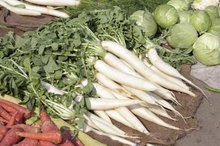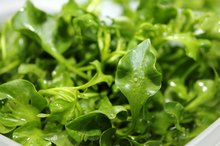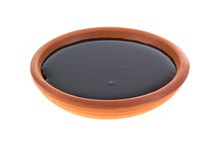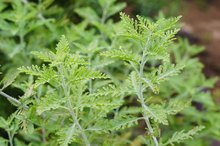What Is Parsley Root Good For?
Parsley is a member of the carrot family that includes celery, fennel, anise and dill. Parsley root is light beige, shaped like a carrot, but slender like a parsnip. The flavor is described as a taste between celery and carrots with a little parsley leaf and turnip. Parsley root has a more delicate, sweeter and more herbal taste than a parsnip. Parsley root is usually eaten cooked but can be served raw, and varieties of parsley root with large fleshy tap roots are used for cooking in Central and Eastern Europe.
Description and History
Both the root and the leaves of parsley root, also called turnip-rooted parsley, are edible. The root was first used for cooking in 16th century Germany, where it is known as Hamburg parsley, and it has large turnip-like roots and fern-like leaves that taste like celery. Parsley root has long been used as a winter vegetable in Germany, Holland and Poland.
Preparation
Green Leafy Vegetables High in Potassium
Learn More
Choose parsley roots that are firm, pale beige, unblemished and small to medium in size as these are the tastiest roots. Preparation for cooking requires removing the leaves and the finer roots and washing by gently scrubbing the root with a brush to remove dirt. Parsley root peel is flavorful, so it is best not to scrape off the skin. Wash, dry and save the green to be used like regular parsley.
Cooked
Parsley roots can be sliced or cubed and prepared as a cooked vegetable in the same way as carrots, celery roots, parsnips and turnips. The roots become tender in about five minutes, but the flavor is not reduced by lengthy cooking. Use parsley root in soups or stews, combined with carrots, potatoes, turnips, onions or meat. It can be roasted or baked with beef or poultry, sautéed or fried with tofu and added to lentil dishes. Parsley root can be steamed, creamed or puréed, or you can boil parsley root and potatoes to create a flavorful variation on traditional mashed potatoes. Roots also can be dried and used for flavoring.
Raw
Can You Eat Daikon Radish Greens?
Learn More
Raw parsley root, with its intense parsley taste, can be used whole, grated, sliced or diced to add an unusual flavor to winter salads. You can shred the crisp-textured parsley root along with other root vegetables to make a raw salad or slaw. Parsley root leaves can be chopped and used for garnishing and flavoring foods.
Medicinal
The leaves, root and seeds of parsley have been used in traditional Greek medicine to treat flatulence, indigestion, spasms and menstrual disorders. Parsley root extract is useful for treating chronic liver and gallbladder diseases because it has diuretic, blood purifying and hepatic qualities. The dried root and essential oil are used in Indian Ayurvedic healing.
Nutrients
Parsley root and parsley are high in vitamins A, C and K and contain copper, iron and iodine. Parsley root is high in sodium, folic acid, potassium, calcium, phosphorus, protein and fiber. It has a substantial amount of flavonoids and is a strong antioxidant.
Warnings
Avoid excessive quantities of parsley root during pregnancy because its oils can stimulate the uterus, cross the placenta and increase fetal heart rate. Parsley root contains natural substances called oxalates, which can cause health problems by becoming too concentrated and crystalizing in your body fluids. For this reason, individuals with kidney or gallbladder conditions should be cautious about consuming parsley root. If you are taking lithium, you should use parsley only under a health practitioner’s guidance, according to New York University Langone Medical Center.
Related Articles
References
Writer Bio
Maura Wolf's published online articles focus on women, children, parenting, non-traditional families, companion animals and mental health. A licensed psychotherapist since 2000, Wolf counsels individuals struggling with depression, anxiety, body image, parenting, aging and LGBTQ issues. Wolf has two Master of Arts degrees: in English, from San Francisco State University and in clinical psychology, from New College.









